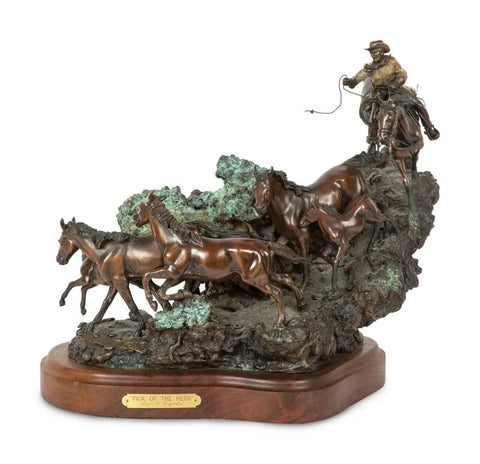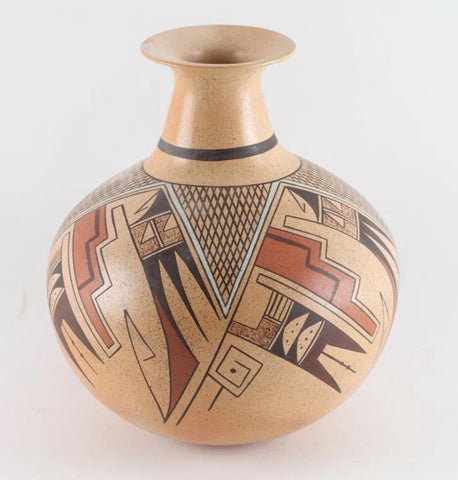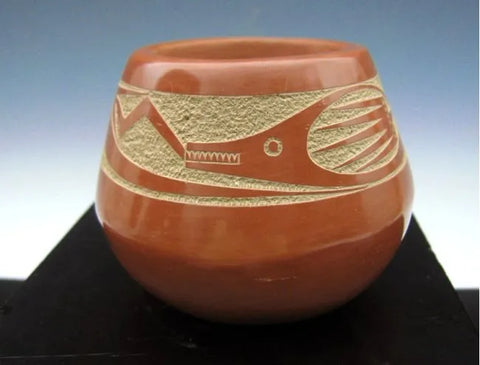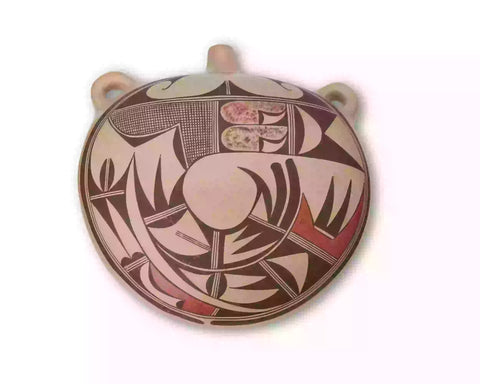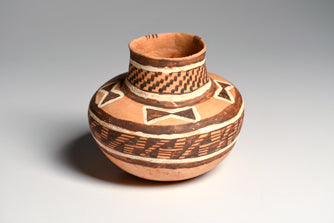
Native American, Homolovi Polychrome Jar with Butterflies, Ca. 1250-1400 A.D., #7003 SOLD
$ 3,250.00
Native American, Homolovi Polychrome Jar with Butterflies, Ca. 1250-1400 A.D., #7003
Description: #7003, Native American, Homolovi Polychrome Jar with Butterflies, Ca. 1250-1400 A.D. Polychrome decorated jar of yellow clay paste pottery, having a tall wide collar neck. Painted in shades of brown and white on an orange ground, with four stylized butterfly elements around the shoulder and various neck and body geometric and solid bands.
Dimensions: 6”W. x 6”H.
Condition: Scattered surface deposits. Intact, exc. condition. A nice example.
Provenance: Private FL. physicians collection. Published: Ancient Origins; American Southwestern Pottery A.D. 600-1600, Preserved by Chance: A Guide to the Ceramic Art of the American Southwest 300-1500 A.D., R. Drapkin 2002. Ex. Dan and Monica King, Tucson, AZ.
The Homol'ovi cluster of archaeological sites includes seven separate pueblo ruins built by various prehistoric people, including ancestors of the Hopi people, between approximately 1260–1400. This fertile area is on a floodplain of the Little Colorado River, and the inhabitants grew cotton, corn, beans, and squash.
The people of this period are called Hisat'sinom, which is the Hopi word for "long-ago people". They are often referred to as Anasazi, as the Navajo guides who helped nineteenth-century anthropologists and archaeologists called them. However, the word "Anasazi" is Navajo for "enemies of our ancestors", and the present-day Hopi population prefer to refer to them as the Hisat'sinom.[2]
Four of the sites are listed on the National Register of Historic Places in Arizona.[4] (Source: Wikipedia)
Description: #7003, Native American, Homolovi Polychrome Jar with Butterflies, Ca. 1250-1400 A.D. Polychrome decorated jar of yellow clay paste pottery, having a tall wide collar neck. Painted in shades of brown and white on an orange ground, with four stylized butterfly elements around the shoulder and various neck and body geometric and solid bands.
Dimensions: 6”W. x 6”H.
Condition: Scattered surface deposits. Intact, exc. condition. A nice example.
Provenance: Private FL. physicians collection. Published: Ancient Origins; American Southwestern Pottery A.D. 600-1600, Preserved by Chance: A Guide to the Ceramic Art of the American Southwest 300-1500 A.D., R. Drapkin 2002. Ex. Dan and Monica King, Tucson, AZ.
The Homol'ovi cluster of archaeological sites includes seven separate pueblo ruins built by various prehistoric people, including ancestors of the Hopi people, between approximately 1260–1400. This fertile area is on a floodplain of the Little Colorado River, and the inhabitants grew cotton, corn, beans, and squash.
The people of this period are called Hisat'sinom, which is the Hopi word for "long-ago people". They are often referred to as Anasazi, as the Navajo guides who helped nineteenth-century anthropologists and archaeologists called them. However, the word "Anasazi" is Navajo for "enemies of our ancestors", and the present-day Hopi population prefer to refer to them as the Hisat'sinom.[2]
Four of the sites are listed on the National Register of Historic Places in Arizona.[4] (Source: Wikipedia)
Related Products
Sold out
Sold out










